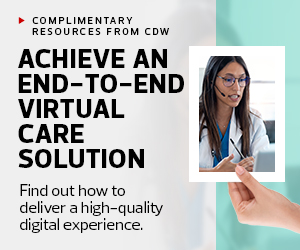1. Reassess Existing Infrastructure to Support Digital Strategy
Pointing to the mantra of “people, process, technology,” Hines refers to technology as a major “building block” of telehealth and recommends that organizations focus heavily on people and process to ensure the technology is used effectively.
The shift in process and mindset is similar to the transition from paper records to electronic health records (EHRs), she says: “We clearly learned that’s not an initiative limited to IT.”
Successful telehealth implementation requires revamping processes for documentation, billing and reimbursement. In doing so, organizations shouldn’t be surprised if they uncover workarounds that clinical and administrative staff had put in place when paper-based workflows were the norm, Hines says. “Once you create a service that depends on automation technology, that’s when you realize the need for standardized processes.”
2. Make Security an Essential Part of Virtual Care
Leveraging a virtual desktop infrastructure (VDI) as part of a telehealth strategy gives clinical professionals the same level of security — and the same user experience — that they are used to with traditional, on-premises technology deployments, Hines says.
This practice of bringing security to the edge can complement digital strategy in two key ways. One is enabling clinical staff to provide care remotely, whether it’s at a community clinic or, in the case of COVID-19 response, from the safety of home. This is particularly helpful for specialties such as oncology, where continuity of care is critical even amid a pandemic, Hines says.
LEARN MORE: Find out why telehealth security is important for healthcare.
The other benefit is the ability to scale services up and down as needed. This could involve setting up a field hospital as part of disaster response or onboarding additional staff due to a patient surge, staff shortage or other short-term need for help. “When VDI is in place, there are no obstacles to ramping up,” Hines says.
3. Make Telehealth Foundational to Care Delivery
Healthcare’s pandemic response demonstrated the long-term viability of telehealth. That means organizations need to look at how to incorporate telehealth into their larger strategy for improving care delivery, Hines says.
“Hours and hours of planning go into construction projects. You look at benefits such as improved throughput, increased capacity and better access to care. Why would we not create a digital health strategy with the same diligence?” Hines says. Telehealth technology should be just as important to the organization as the EHR or the imaging system, she adds: “It is a critical clinical application. It can’t go down.”
Click the banner below to achieve an end-to-end virtual care solution with guidance from CDW.












